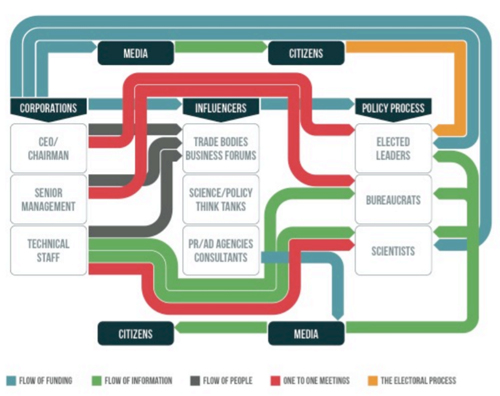En organisation som kallar sig “InfluenceMap” har kartlagt och redovisat hur ett antal större företag beter sig när det gäller klimatavtalet. Framför allt har de inriktat sig på hur de agerar för att få som de vill. I en lista (Corporate Carbon Policy Footprint - the 50 Most Influential) visar de 35 som starkt motsätter sig klimatåtgärder och 15 som arbetar för att sådana skall vidtas, Bild 1. Och i rapporten visar de hur företaget försöker påverka opinion och politiker
Spännande läsning och den som önskar kan registrera sig för att ta del av deras databas mera i detalj, Bild 2.
* 35 of the 50 most influential are actively lobbying against climate policy. They include companies in the fossil fuel value chain (ExxonMobil, Valero Energy, Chevron), energy intensive
companies (BASF, ArcelorMittal, Bayer, Dow Chemical and Solvay) and electric utilities with large amounts of coal generating capacity (Southern Company, Duke Energy and American Electric Power).
* Also in this group of 35 influential companies holding back climate policy are four powerful automotive manufacturers (Fiat Chrysler, Ford, BMW and Daimler). The research found the
companies lobbying to delay or dilute efficiency and CO2 emissions standards and procedures both in Europe and North America. Depending on region, passenger vehicle emissions account
for 12% or more of all greenhouse gas emissions.
* On the other side, 15 of the 50 most influential are pushing for an ambitious climate policy agenda, favouring renewable power and electric vehicles. They include signatories to the RE100
initiative committing to buying 100% renewable power (Apple, Ikea, Unilever, Coca Cola and Nestle) as well as power sector companies (SSE, Enel, EDF, Iberdrola and National Grid) who are
shifting their business models towards low carbon electricity generation.

Bild 1: Resultat av kartläggningen
———-

Bild 2: Påverkansmetoder
Skrivet av Hans Nilsson, 2017-09-20.
(0) Kommentarer • Permalink
